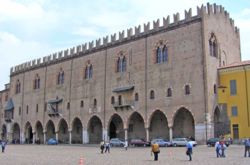Ducal Palace, Mantua

The Palazzo Ducale di Mantova ("Ducal Palace") is a group of buildings in the Italian city of Mantua (Lombardy), built between the 14th and the 17th century mainly by the noble family of Gonzaga as their royal residence in the capital of their Duchy. The buildings are connected by corridors and galleries and are enriched by inner courts and wide gardens. The complex includes some 500 rooms and occupies an area of c. 34,000 m². Although most famous for Mantegna's frescos in the Camera degli Sposi (Wedding Room), they have many other very significant architectural and painted elements.
History

The most ancient parts of the palace are the Palazzo del Capitano, built in the early 14th century by the Captain of the People Guido Buonacolsi (whose family ruled Mantua from 1271 to 1328) and the Magna Domus. At the end of the same century, Bartolino da Novara, one of the most renowned military architects of the time, erected the Castle of St. George.
The Domus Nova was finished a century later by Luca Fancelli. He is responsible for the part called Corte Nuova ("New Court"), including the ducal apartments with famous fresco cycles by Giulio Romano.
The church of Santa Barbara, which had the role of Palace chapel ("Basilica Palatina") for the Gonzagas, was designed by Giovan Battista Bertani. Between the 16th and the 17th century, the painter and architect Antonio Maria Viani built the apartment of Vincenzo I and the so called Room of Metamorphoses and Loggia of Eleonora.
The Gonzaga lived in the palace from 1328 to 1707, when the dynasty extinguished. Subsequently the edifices saw a sharp decline, which was halted in the 20th century with a continue process of restoration and the destination of the area as museum.
Overview

The entrance of the palace is from Piazza Sordello, to which the most ancient edifices, the Palazzo del Capitano and the Magna Domus, open. The monumental Scalone delle Duchesse ("Duchesses' Staircase"), built in the 17th century and renovated in 1779 by Paolo Pozzo, leads to the Room of the Morone, named after the 1494 canvas of the Veronese painter Domenico Morone and portraying the Expulsion of the Bonacolsi in 1328 (scene from Piazza Sordello). In the noble floor of the Captain's Palace is the First Room of Guastalla, with a fresco frieze with portraits of the Gonzaga family, which once extended to the successive room, the Room of Pisanello. Antonio Pisano was commissioned, after 1433, to paint frescoes depicting a Tournament and other scenes, which were left unfinished.

The Galleria Nuova is a corridor built in 1778 by Giuseppe Piermarini to connect the Guastalla apartment to the Duke apartment. It houses several altarpieces from the early 16th century to the late 18th century by Francesco Borgani, Carlo Bononi, Spagnoletto and others. The gallery ends with the great Sala degli Arcieri ("Room of the Archers"), once housing the apartment of Duke Vincenzo. It is famous for an altarpiece by Peter Paul Rubens (1605), originally part of a triptych for the church of Santissima Trinità in the city, portraying the Gonzaga Family in Adoration of the Holy Trinity.
Then the Galleria degli Specchi ("Mirrors Gallery") follows: this was built as an open loggia under Vincenzo I, with a neoclassicist decoration added in 1773-1779. The vault is frescoed by two pupils of Guido Reni.
External links
